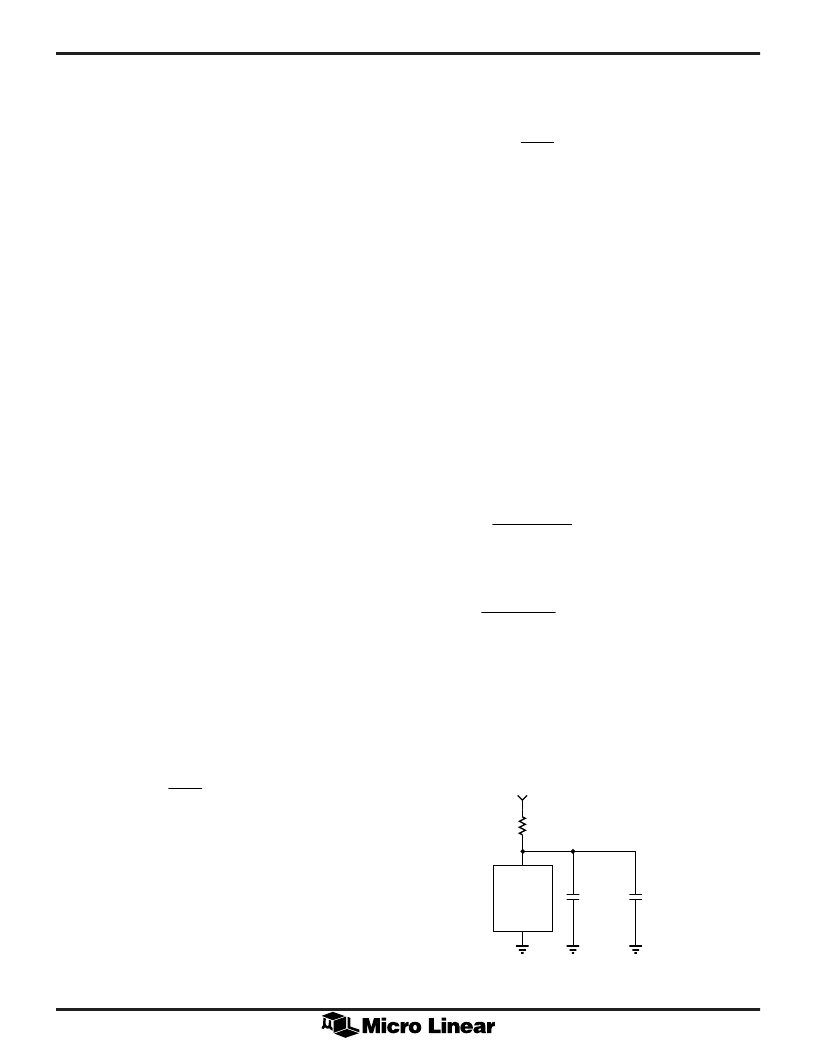- 您現(xiàn)在的位置:買賣IC網(wǎng) > PDF目錄359170 > ML4824CS2 (FAIRCHILD SEMICONDUCTOR CORP) Power Factor Correction and PWM Controller Combo PDF資料下載
參數(shù)資料
| 型號(hào): | ML4824CS2 |
| 廠商: | FAIRCHILD SEMICONDUCTOR CORP |
| 元件分類: | 穩(wěn)壓器 |
| 英文描述: | Power Factor Correction and PWM Controller Combo |
| 中文描述: | 0.5 A POWER FACTOR CONTROLLER WITH POST REGULATOR, 250 kHz SWITCHING FREQ-MAX, PDSO16 |
| 封裝: | SOIC-16 |
| 文件頁數(shù): | 10/16頁 |
| 文件大?。?/td> | 262K |
| 代理商: | ML4824CS2 |

ML4824
10
FUNCTIONAL DESCRIPTION
(Continued)
Figure 3. External Component Connections to V
CC
No voltage error amplifier is included in the PWM stage
of the ML4824, as this function is generally performed on
the output side of the PWM’s isolation boundary. To
facilitate the design of optocoupler feedback circuitry, an
offset has been built into the PWM’s RAMP 2 input which
allows V
DC
to command a zero percent duty cycle for
input voltages below 1.25V.
PWM Current Limit
The DC I
LIMIT
pin is a direct input to the cycle-by-cycle
current limiter for the PWM section. Should the input
voltage at this pin ever exceed 1V, the output of the PWM
will be disabled until the output flip-flop is reset by the
clock pulse at the start of the next PWM power cycle.
V
IN
OK Comparator
The V
IN
OK comparator monitors the DC output of the PFC
and inhibits the PWM if this voltage on V
FB
is less than its
nominal 2.5V. Once this voltage reaches 2.5V, which
corresponds to the PFC output capacitor being charged to
its rated boost voltage, the soft-start begins.
PWM Control (RAMP 2)
When the PWM section is used in current mode, RAMP 2
is generally used as the sampling point for a voltage
representing the current in the primary of the PWM’s
output transformer, derived either by a current sensing
resistor or a current transformer. In voltage mode, it is the
input for a ramp voltage generated by a second set of
timing components (R
RAMP2
, C
RAMP2
), which will have a
minimum value of zero volts and should have a peak
value of approximately 5V. In voltage mode operation,
feedforward from the PFC output buss is an excellent way
to derive the timing ramp for the PWM stage.
Soft Start
Start-up of the PWM is controlled by the selection of the
external capacitor at SS. A current source of 50μA supplies
the charging current for the capacitor, and start-up of the
PWM begins at 1.25V. Start-up delay can be programmed
by the following equation:
C
t
A
V
SS
DELAY
=
′
50
125
.
μ
(6)
where C
SS
is the required soft start capacitance, and
t
DELAY
is the desired start-up delay.
It is important that the time constant of the PWM soft-start
allow the PFC time to generate sufficient output power for
the PWM section. The PWM start-up delay should be at
least 5ms.
Solving for the minimum value of C
SS
:
C
ms
5
A
V
nF
SS
=
′
=
50
125
.
200
μ
Generating V
CC
The ML4824 is a current-fed part. It has an internal shunt
voltage regulator, which is designed to regulate the voltage
internal to the part at 13.5V. This allows a low power
dissipation while at the same time delivering 10V of gate
drive at the PWM OUT and PFC OUT outputs. It is
important to limit the current through the part to avoid
overheating or destroying it. This can be easily done with a
single resistor in series with the Vcc pin, returned to a bias
supply of typically 18V to 20V. The resistor’s value must be
chosen to meet the operating current requirement of the
ML4824 itself (19mA max) plus the current required by the
two gate driver outputs.
EXAMPLE:
With a V
BIAS
of 20V, a V
CC
limit of 14.6V (max) and the
ML4824 driving a total gate charge of 110nC at 100kHz
(e.g., 1 IRF840 MOSFET and 2 IRF830 MOSFETs), the gate
driver current required is:
I
kHz
nC
mA
GATEDRIVE
=
′
=
100
100
11
(7)
R
V
V
mA
mA
BIAS
=
-
+
=
20
146
19
11
180
.
(8)
To check the maximum dissipation in the ML4824, find
the current at the minimum V
CC
(12.4V):
I
V
V
mA
CC
=
-
=
20
12 4
180
422
.
.
(9)
The maximum allowable I
CC
is 55mA, so this is an
acceptable design.
The ML4824 should be locally bypassed with a 10nF and
a 1
μ
F ceramic capacitor. In most applications, an
electrolytic capacitor of between 100
μ
F and 330
μ
F is also
required across the part, both for filtering and as part of
the start-up bootstrap circuitry.
ML4824
VCC
GND
VBIAS
10nF
CERAMIC
1μF
CERAMIC
RBIAS
相關(guān)PDF資料 |
PDF描述 |
|---|---|
| ML4824CP1 | Power Factor Correction and PWM Controller Combo |
| ML4824CP-2 | Power Factor Correction and PWM Controller Combo |
| ML4824IS2 | Power Factor Correction and PWM Controller Combo |
| ML4824CS-1 | Power Factor Correction and PWM Controller Combo |
| ML4824CP-1 | Power Factor Correction and PWM Controller Combo |
相關(guān)代理商/技術(shù)參數(shù) |
參數(shù)描述 |
|---|---|
| ML4824CS-2 | 制造商:MICRO-LINEAR 制造商全稱:MICRO-LINEAR 功能描述:Power Factor Correction and PWM Controller Combo |
| ML4824CS2_Q | 功能描述:功率因數(shù)校正 IC PFC Controller PWM Combo RoHS:否 制造商:Fairchild Semiconductor 開關(guān)頻率:300 KHz 最大功率耗散: 最大工作溫度:+ 125 C 安裝風(fēng)格:SMD/SMT 封裝 / 箱體:SOIC-8 封裝:Reel |
| ML4824CS2X | 功能描述:功率因數(shù)校正 IC PFC Controller PWM Combo RoHS:否 制造商:Fairchild Semiconductor 開關(guān)頻率:300 KHz 最大功率耗散: 最大工作溫度:+ 125 C 安裝風(fēng)格:SMD/SMT 封裝 / 箱體:SOIC-8 封裝:Reel |
| ML4824IP1 | 功能描述:功率因數(shù)校正 IC PFC Controller PWM Combo RoHS:否 制造商:Fairchild Semiconductor 開關(guān)頻率:300 KHz 最大功率耗散: 最大工作溫度:+ 125 C 安裝風(fēng)格:SMD/SMT 封裝 / 箱體:SOIC-8 封裝:Reel |
| ML4824IP-1 | 制造商:MICRO-LINEAR 制造商全稱:MICRO-LINEAR 功能描述:Power Factor Correction and PWM Controller Combo |
發(fā)布緊急采購(gòu),3分鐘左右您將得到回復(fù)。